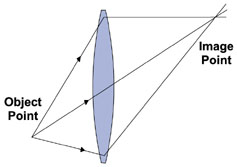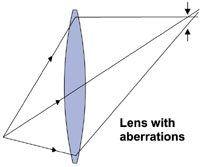Optipedia • SPIE Press books opened for your reference.
Aberrations
Excerpt from Field Guide to Optical Lithography
An aberration is any deviation from the ideal, “diffraction-limited” imaging performance of a lens. In practice, aberrations come from three sources—aberrations of design, aberrations of construction, and aberrations of use.
 An “aberration of design” does not mean mistakes or problems caused by the designer of the lens. Aberrations are fundamental to the nature of imaging and it is the goal of the lens designer to “design out” as many of these aberrations as possible. The aberrations of design are those aberrations, inserted into the imaging system by the nature of light, that the designer was not able to extract through clever design.
An “aberration of design” does not mean mistakes or problems caused by the designer of the lens. Aberrations are fundamental to the nature of imaging and it is the goal of the lens designer to “design out” as many of these aberrations as possible. The aberrations of design are those aberrations, inserted into the imaging system by the nature of light, that the designer was not able to extract through clever design.
In terms of geometrical optics, the goal of imaging can be stated very simply: light emanating in all directions from some point on the object should be collected by the lens and focused to its ideal image point. Thus, a ray of light coming from the object point should pass through the lens and arrive at the image point, regardless of its angle.
some point on the object should be collected by the lens and focused to its ideal image point. Thus, a ray of light coming from the object point should pass through the lens and arrive at the image point, regardless of its angle.
Some typical examples of aberrations are tilt, defocus, coma, astigmatism, spherical aberration, and chromatic aberration.
C. A. Mack, Field Guide to Optical Lithography, SPIE Press, Bellingham, WA (2006).
View SPIE terms of use.

